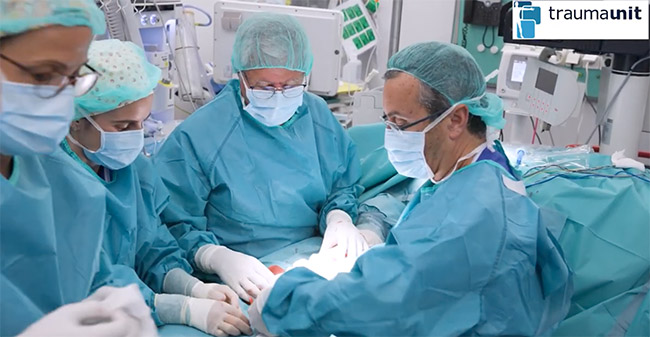Peripheral Nerve Surgery for an Injury in Continuity | Full Procedure | Dr. Casañas

As a surgeon specialized in peripheral nerves, we are addressing a complex surgery to treat a median nerve injury in continuity. This procedure involves the use of a sural nerve graft to restore the sensory function of the median nerve and a nerve transfer to reinnervate the abductor pollicis brevis (APB) muscle using the anterior interosseous nerve (AIN). Intraoperative neurophysiological monitoring (IONM) is employed throughout the surgery to guide and ensure precision in every step.
1. Preoperative Assessment and Exposure of the Median Nerve
We begin by exposing the median nerve in the forearm using microsurgical techniques to minimize damage to surrounding tissues. In this surgery, we are dealing with an injury in continuity, meaning the nerve is not fully severed but has intraneural damage that affects its ability to conduct impulses. Our goal is to restore both sensory and motor functions using different techniques.
Intraoperative Monitoring (IONM) to Identify Healthy and Damaged Areas
IONM is critical from the start of the surgery. We use this monitoring to assess the integrity of the nerve fibers in the injured area.
- Identification of the Healthy Stump of the Median Nerve: Using IONM, we stimulate the median nerve both proximally and distally to the injury. This allows us to precisely identify the point where the nerve is healthy, ensuring that the section of the nerve we use for coaptation is viable and will function properly.
2. Identification of the Thenar Branch and Planning the Nerve Transfer
Once the healthy portion of the median nerve is identified, we proceed to locate the thenar branch, the motor branch responsible for innervating the thenar muscles, including the APB.
Evaluating the Nerve Action Potential of the Thenar Branch
Using intraoperative neurophysiological monitoring (IONM), we stimulate the thenar branch to assess its motor response capacity. This confirms that the thenar branch is intact and viable for receiving a nerve transfer. We have detected an appropriate electrical response in the APB, which is essential for ensuring functional motor recovery.
3. Nerve Transfer from the Anterior Interosseous Nerve (AIN) to the Thenar Branch
We decide to reinnervate the APB by performing a nerve transfer from the anterior interosseous nerve (AIN) to the thenar branch of the median nerve. This decision is based on the AIN's capacity to provide specific and effective motor reinnervation.
Identification of the AIN Action Potential
Using IONM, we stimulate the AIN and verify that it has an appropriate action potential to act as a viable motor donor.
- Coaptation of the AIN to the Thenar Branch: Under microsurgical magnification, we carefully coapt the AIN to the isolated thenar branch, ensuring precise alignment of the motor fibers to restore the function of the APB.
4. Sural Nerve Graft for Sensory Function of the Median Nerve
With the nerve transfer completed, we proceed to repair the sensory portion of the median nerve using a sural nerve graft. The sural nerve, which is purely sensory, is ideal for replacing the damaged sensory portion of the median nerve.
Preparing and Suturing the Sural Nerve Graft
- Harvesting the Sural Nerve Graft: We harvest the sural nerve from the patient, selecting a suitable length to bridge the gap in the median nerve that has been resected.
- Suturing the Graft with Four Strands: The graft is sutured to the median nerve with four strands, ensuring precise alignment of the sensory fascicles to maximize nerve regeneration and restore sensory function.
5. Creating an Additional Cable for the Motor Branch of the APB
To optimize motor restoration, we create an additional cable from the AIN branch directly to the thenar branch, specifically aimed at reinnervating the abductor pollicis brevis (APB) muscle.
Placement of the Extra Cable
This extra cable is carefully sutured using microsurgical techniques and IONM to ensure proper coaptation and allow precise reinnervation of the APB.
6. Final Evaluation with IONM and Surgical Closure
At the end of the surgery, we use intraoperative neurophysiological monitoring (IONM) to verify the integrity and functionality of all nerve repairs:
- Verification of APB Functionality: We stimulate the AIN and check the response in the APB. A proper response confirms that the nerve transfer has been successful and that the APB is receiving adequate motor innervation.
- Confirmation of the Sural Nerve Graft Integrity: We evaluate the conductivity of the sural nerve graft, ensuring it is properly aligned and that the sensory fascicles are prepared for regeneration.
Conclusion and Prognosis
With careful wound closure, we have completed a surgery that combines advanced nerve transfer and nerve grafting techniques to restore both motor and sensory functions of the median nerve. The transfer of the anterior interosseous nerve to the thenar branch, along with the suturing of the sural nerve graft, offers the patient the best opportunity for complete functional recovery.
Thanks to the use of intraoperative neurophysiological monitoring, we were able to perform this surgery with maximum precision, ensuring that each nerve connection is optimal for regeneration and functional recovery. We expect to see signs of nerve regeneration in the coming months, with a favorable prognosis for both motor and sensory recovery.
This case highlights the importance of meticulous surgical planning and precise execution in repairing complex nerve injuries. The combination of nerve grafts, advanced technologies like intraoperative monitoring, and microsurgical techniques allows for the restoration of both sensory and motor functions in affected peripheral nerves, significantly improving the patient's quality of life.